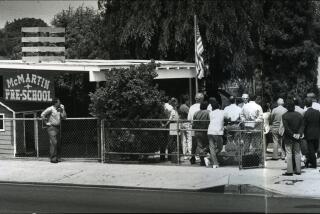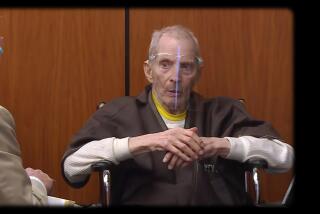Robert Durst murder trial: Witnesses testify to abuse of first wife

- Share via
More than 40 years ago, in a tavern on the east side of Manhattan, James McCormack met his little sister’s boyfriend.
Even then, Robert Durst seemed odd, McCormack recalled on the witness stand Thursday. Intelligent, if disengaged. A dry, almost cruel sense of humor. “If someone tripped,” McCormack said, “he would laugh.”
Beginning with her childhood on Long Island and ending with her disappearance in 1982, McCormack led the jury through the life of his youngest sister, Kathleen, who married Durst in 1973 and vanished nine years later. But in this murder trial, McCormack’s sister is not the victim.
Los Angeles prosecutors are trying to pull off a Russian doll set of a case, nesting the murder of Susan Berman, Durst’s close friend and confidante, within the disappearance of Kathie Durst. They allege Durst killed his wife in 1982, then, years later, eliminated the only person who could tie him to the crime — Berman.
Durst, 76, has never been charged with his wife’s murder. He has pleaded not guilty in the death of Berman, whose body was found in her Benedict Canyon home on Dec. 24, 2000, shot execution-style in the back of the head.
On Thursday, jurors in a Los Angeles courtroom heard from McCormack, Kathie’s sister, Virginia McKeon; and her nursing school instructor and friend, Marion Watlington.
Kathie grew up in a middle-class Long Island family, her siblings said. Their father was a service representative for a telephone company, their mother a homemaker. All five of the McCormack siblings worked in high school; Kathie, the youngest, took a job in a local dentist’s office.
After finishing high school, she moved to Manhattan with a friend and worked as a dental hygienist. In the early 1970s, McCormack learned she was seeing Robert Durst.
Durst was 11 years her senior, the scion of a family that controlled some of New York’s most coveted real estate. His sister seemed happy with him, McCormack said, but by the mid-1970s, their relationship had grown strained. McCormack learned later, he said, that Durst forced his sister to get an abortion “under threat of a divorce.”
After that, McCormack said, Kathie seemed to focus on herself. She enrolled in nursing school, with an eye toward attending medical school and becoming a pediatrician. It was clear, he said, she had “grown past Bob, intellectually and emotionally,” and that he reacted by becoming “more curt, more dismissive of her points of view.”
One Christmas, he recalled, Kathie was relaxing on their mother’s couch after dinner, sipping a glass of red wine. Durst wanted to leave and insisted she get up. When she didn’t, he grabbed the top of her head and yanked her to her feet in front of her family, McCormack testified. “It was so spontaneous and unexpected,” he said.
Beginning in late 1980, Watlington, who taught Kathie at Western Connecticut State University, said she began fielding long, late-night phone calls from Kathie, calls that were “very angry, upset, distraught.”
When they met in 1977, Watlington was a brand new instructor. Kathie was among her first class of nursing students. She struck Watlington, who is now a doctor in Bermuda, as “head and shoulders over the students around her.” She was curious, confident and “effervescent,” Watlington said.
But several years later, when she started calling Watlington late at night, her tenor had changed. She rambled and, on one occasion, she sounded drunk, Watlington said. She said Durst was beating her, to the point she had to be hospitalized, Watlington recalled. She urged her to leave. Kathie said she would, but that she needed to gather some paperwork before seeking a divorce, Watlington testified.
“If anything should happen to me,” she recalled Kathie saying, “don’t let the bastard get away with it.”
A few weeks later, Watlington saw Kathie’s picture in the New York Post. She had vanished on Jan. 31, 1982. Watlington dialed the hotline beneath the picture and told a policeman what Kathie had confided in her. He was dismissive, Watlington said, and hung up before taking down her name or a way to contact her.
McCormack, meanwhile, was growing frustrated with Michael Struk, the New York Police Department detective tasked with investigating Kathie’s disappearance. He called potter’s fields to ask about unclaimed female bodies, he testified, and hospitals “from Massachusetts to Pennsylvania” to inquire about patients with amnesia.
As he searched, Durst seemed disinterested and cold, McCormack said. Less than two months after she vanished, Durst asked him to retrieve Kathie’s belongings from a lake house they had lived in, he testified. When he got there, he found just a fishing pole, net and a pair of rubber boots – her other possessions were gone, inexplicably, he said.
In mid-1982, McCormack said, Det. Struk told him he was passing off the investigation to a unit that handles cold cases. “I blew up,” he recalled. “I said, ‘This is not a cold case. This is my baby sister.’”
Lead prosecutor John Lewin finished his questioning by asking McCormack if he had any doubts his little sister was dead. “Kathie is not with us, period,” he replied. And is there any doubt, Lewin asked, whether his sister was killed the day she went missing?
“There’s no doubt in my mind,” McCormack said, staring for the first and only time directly at Durst, now a wizened septuagenarian listening to his testimony through hearing aids, “that she died on January 31, 1982.”
Testimony is scheduled to continue Monday.
More to Read
Sign up for Essential California
The most important California stories and recommendations in your inbox every morning.
You may occasionally receive promotional content from the Los Angeles Times.










